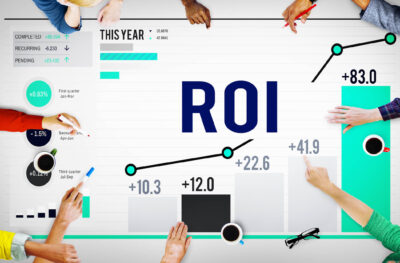Measuring healthcare marketing ROI is a crucial aspect of any marketing campaign. It allows you to determine the success of your marketing efforts and make data-driven decisions to improve future campaigns. ROI, or return on investment, is a measure of the financial success of your marketing efforts, and it tells you whether the money you’ve invested in marketing is generating a positive return or not.

Understanding Healthcare Marketing ROI
As a healthcare marketer, you need to know how to measure the success of your marketing efforts. One of the most important metrics to track is Return on Investment (ROI). In this section, we’ll define what ROI is in healthcare marketing and why it’s important.
Defining ROI in Healthcare Marketing
ROI is a financial metric that measures the profit or loss generated by an investment relative to the amount of money invested. In healthcare marketing, ROI is used to determine the effectiveness of your marketing campaigns. By tracking ROI, you can see which campaigns are generating revenue and which ones are not.
To calculate ROI, you need to know two things: the revenue generated by your marketing campaign and the cost of the campaign. Once you have these numbers, you can use the following formula:
ROI = (Revenue – Cost) / Cost
For example, if you spent $10,000 on a marketing campaign and generated $20,000 in revenue, your ROI would be:
ROI = ($20,000 – $10,000) / $10,000 = 1
This means that for every dollar you invested in the campaign, you generated $1 in revenue.
Importance of ROI in Healthcare
Healthcare marketing ROI is critical because it helps you make data-driven decisions about your marketing strategy. It is an otherwise simplified version of helping you understand all those other metrics that bog you down, such as click-through-rates, email open rates, impressions, and shares, among others. More importantly, healthcare marketing ROI allows you to allocate your marketing budget more effectively and maximize your returns.
In addition, tracking ROI can help you identify areas where you can improve your marketing strategy. For example, if you see that a particular campaign has a low ROI, you can analyze the campaign to see what went wrong and make changes for future campaigns.
Overall, understanding healthcare marketing ROI is essential for any healthcare marketer who wants to maximize their returns on marketing investment.
Key Components of Healthcare Marketing ROI
Measuring the return on investment (ROI) of your healthcare marketing campaign is essential to understanding its effectiveness. There are three key components of marketing ROI that you should focus on: cost analysis, revenue attribution, and profit margin assessment.

Cost Analysis
Cost analysis involves tracking the costs associated with your marketing campaign. This includes the cost of creating and distributing marketing materials, as well as any advertising costs. By tracking these costs, you can determine the cost per acquisition (CPA) of each new patient or customer. This metric is important because it allows you to evaluate the efficiency of your marketing campaign and identify areas where you can cut costs.
Revenue Attribution
Revenue attribution involves tracking the revenue generated by your marketing campaign. This includes revenue generated from new patients or customers, as well as revenue generated from existing patients or customers who were influenced by your marketing campaign. By tracking revenue attribution, you can determine the return on investment of your marketing campaign.
Profit Margin Assessment
Profit margin assessment involves evaluating the profitability of your marketing campaign. This includes calculating the profit margin for each new patient or customer, as well as the overall profit margin for your marketing campaign. By evaluating the profit margin, you can determine the financial impact of your marketing campaign on your organization.
1. Data Collection and Management
When it comes to measuring healthcare marketing ROI, data collection and management are crucial. In this section, we will cover the two key aspects of data collection and management: data sources and data quality.
Data Sources
To accurately measure your healthcare marketing ROI, you need to collect data from a variety of sources. Some of the most important data sources include:

- Electronic health record (EHR) and electronic medical record (EMR) systems
- Customer relationship management (CRM) systems
- Website analytics tools, such as Google Analytics
- Social media analytics tools, such as Hootsuite or Sprout Social
- Marketing automation tools, such as HubSpot or Marketo
By collecting data from these sources, you can gain a comprehensive view of your healthcare marketing performance. For example, you can track website traffic, social media engagement, email open rates, and more.
Data Quality
Of course, collecting data is only half the battle. You also need to accurately measure your healthcare marketing ROI by ensuring that your data is of high quality. Here are a few tips for maintaining data quality:
- Standardize your data: Make sure that your data is consistent across all sources. For example, if you’re tracking website traffic, make sure that you’re using the same tracking codes across all pages.
- Clean your data: Regularly review your data for errors or inconsistencies. For example, if you notice that a particular email campaign has a high bounce rate, investigate the cause and correct any errors.
- Validate your data: Double-check your data to ensure that it’s accurate. For example, if you’re tracking leads in your CRM system, make sure that each lead is properly tagged and categorized.
By maintaining high-quality data, you can ensure that your healthcare marketing ROI measurements are accurate and reliable.
2. Analytical Methods for Measuring Healthcare Marketing ROI
Measuring the return on investment of your healthcare marketing efforts is crucial to determine the effectiveness of your campaigns. There are two main analytical methods for measuring ROI: quantitative analysis and qualitative analysis.

Quantitative Analysis
Quantitative analysis involves using numerical data to evaluate the ROI of your healthcare marketing campaigns. Some of the key metrics to consider include:
- Cost per acquisition (CPA): This metric measures the cost of acquiring a new patient. It is calculated by dividing the total cost of your marketing campaign by the number of new patients acquired.
- Conversion rate: This metric measures the percentage of website visitors who take a desired action, such as filling out a form or scheduling an appointment.
- Customer lifetime value (CLV): This metric measures the total value of a patient over the course of their relationship with your healthcare organization.
By analyzing these metrics, you can gain insights into the effectiveness of your healthcare marketing campaigns and make data-driven decisions to optimize your ROI.
Qualitative Analysis
Qualitative analysis involves gathering subjective data to evaluate the ROI of your healthcare marketing campaigns. Some of the key methods for qualitative analysis include:
- Patient surveys: Surveys can help you gather feedback from patients about their experiences with your healthcare organization and the effectiveness of your marketing campaigns.
- Social media listening: Monitoring social media channels can help you gain insights into patient sentiment and identify areas for improvement in your healthcare marketing campaigns.
- Focus groups: Focus groups can provide valuable feedback from patients and help you identify areas for improvement in your healthcare marketing campaigns.
Combining quantitative and qualitative analysis can help you gain a comprehensive understanding of the ROI of your healthcare marketing campaigns and make data-driven decisions to optimize your marketing efforts.
3. Marketing Strategies and ROI
If you’re looking to measure the ROI of your healthcare marketing campaigns, you need to take a close look at your marketing strategies.

Digital Marketing
Digital marketing is a popular strategy for healthcare marketers, and for good reason. It can be highly targeted, cost-effective, and measurable. By using tools like Google Analytics, you can track the ROI of your digital marketing campaigns in real time. Some common digital marketing tactics include:
- Search engine optimization (SEO)
- Pay-per-click (PPC) advertising
- Social media marketing
- Content marketing
Traditional Marketing
Traditional marketing tactics like print ads, billboards, and TV commercials can still be effective in healthcare marketing. However, they can be more difficult to measure in terms of ROI. With traditional marketing, it’s important to track metrics like brand awareness and customer engagement to get a sense of how your campaigns are performing.
Multi-Channel Marketing
Multi-channel marketing involves using a combination of digital and traditional marketing tactics to reach your target audience. By using multiple channels, you can increase the reach and effectiveness of your campaigns. However, it can also make it more difficult to track ROI. To get the most out of multi-channel marketing, you need to have a solid tracking and analytics plan in place.
4. Challenges in Measuring Healthcare Marketing ROI
Measuring healthcare marketing ROI is a complex process that poses several challenges. Here is a discussion of some of the main challenges that healthcare marketers face when trying to measure the ROI of their marketing campaigns.
Regulatory Compliance
The healthcare industry is heavily regulated, and marketers must comply with various laws and regulations when promoting their products and services. This can make it difficult to measure the ROI of marketing campaigns since some of the metrics that marketers typically use, such as sales or revenue, may not be directly related to the marketing efforts.

To address this challenge, healthcare marketers must ensure that their campaigns comply with all relevant regulations and laws. They must also use metrics that are relevant to their goals and objectives, such as patient engagement or satisfaction.
Attribution Modeling
Another challenge in measuring healthcare marketing ROI is attribution modeling. Attribution modeling is the process of assigning credit to various touchpoints in the patient journey, such as website visits, phone calls, or in-person visits, to determine which touchpoints are most effective in driving conversions.
In healthcare marketing, attribution modeling can be particularly challenging since patients may interact with multiple touchpoints before converting. To address this challenge, healthcare marketers can use various attribution models, such as first touch or last touch, to determine which touchpoints are most effective in driving conversions.
Long-Term vs Short-Term ROI
Finally, healthcare marketers must consider the long-term and short-term ROI of their marketing campaigns. While short-term ROI can be easier to measure, long-term healthcare marketing ROI can be more challenging since it may take months or even years to see the full impact of a marketing campaign.
To address this challenge, healthcare marketers must use metrics that are relevant to their goals and objectives, such as patient engagement or satisfaction, and track these metrics over time to determine the long-term impact of their marketing campaigns.
5. Improving Healthcare Marketing ROI
Measuring ROI will help you determine if your marketing efforts are generating the desired results. Here are some techniques to optimize your healthcare marketing ROI:
Optimization Techniques

Optimizing your healthcare marketing campaign is essential to improve your ROI. You can optimize your campaign by:
- Conducting A/B testing to determine which marketing strategies are most effective.
- Creating targeted marketing campaigns for specific demographics.
- Using search engine optimization (SEO) to improve your search engine rankings.
- Creating valuable content that educates and informs your target audience.
Performance Monitoring
Monitoring the performance of your healthcare marketing campaign is critical to improving your ROI. You can monitor your campaign performance by:
- Tracking your website traffic and analyzing your conversion rates.
- Monitoring your social media engagement and interactions.
- Analyzing your email marketing campaign metrics such as open rates, click-through rates, and conversion rates.
ROI Improvement Strategies
To improve your healthcare marketing ROI, you can implement the following strategies:
- Focus on cost per acquisition (CPA) and conversion rates to determine which marketing strategies are generating the highest ROI.
- Use retargeting to reach out to potential customers who have previously interacted with your brand.
- Invest in marketing automation to increase the efficiency of your marketing campaigns and improve your ROI.
Key Takeaways
Measure ROI over a longer period
According to a LinkedIn study, healthcare providers measure healthcare marketing ROI too quickly, with only 4% of marketers measuring ROI over a six-month period or longer. This approach can lead to inaccurate measurements and missed opportunities. By measuring healthcare marketing ROI over a longer period, you can get a more accurate picture of your marketing effectiveness and make better decisions about where to invest your resources.
Focus on the patient experience
Ultimately, healthcare marketing ROI is significantly anchored on improving patient experience and potentially improving health outcomes. This means that marketers need to focus on measuring the effects of their marketing efforts on patient outcomes, not just on revenue or conversions. By focusing on the patient experience, you can create more effective marketing campaigns that resonate with your target audience and drive better results.
